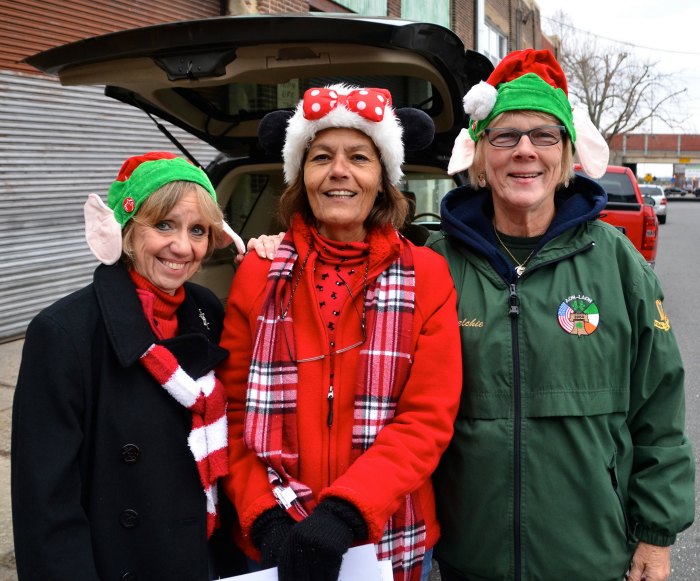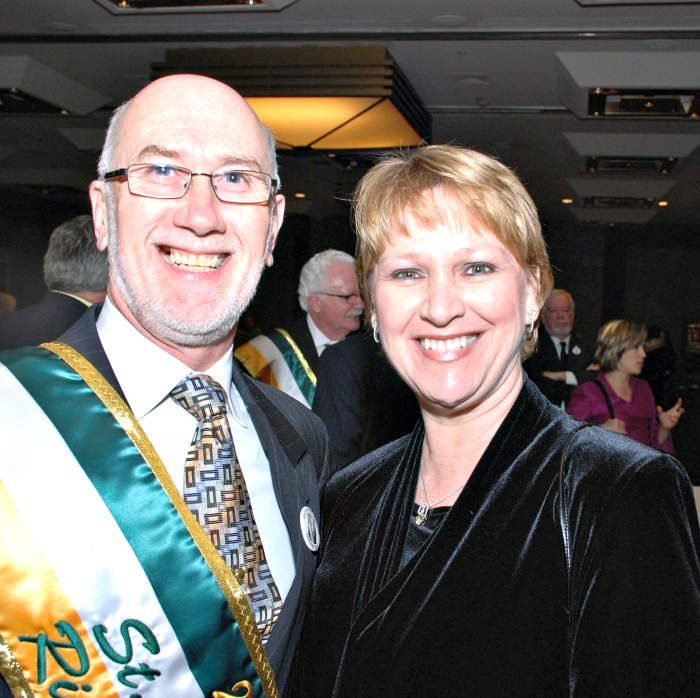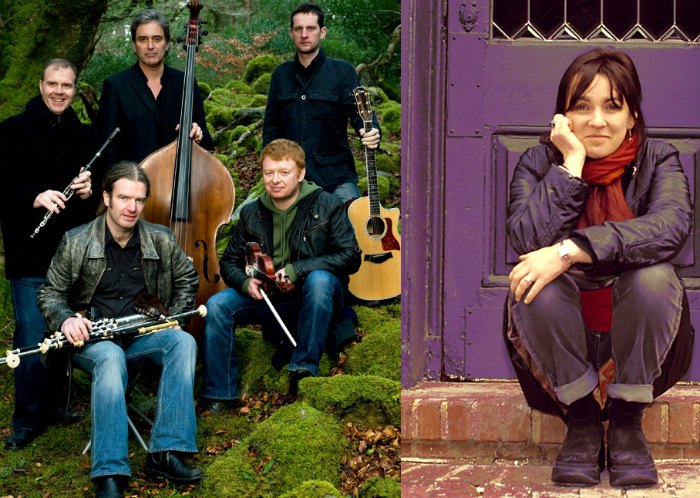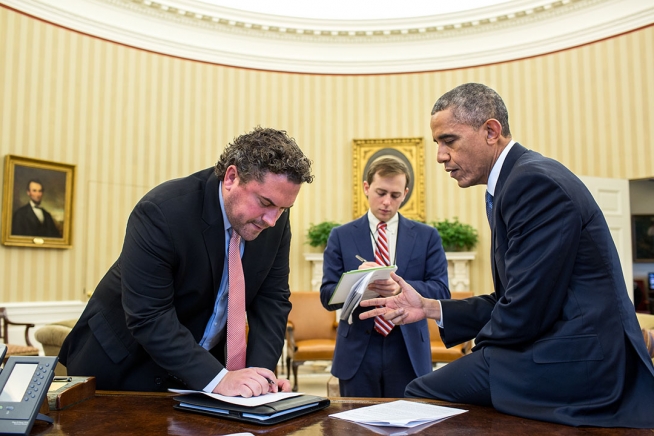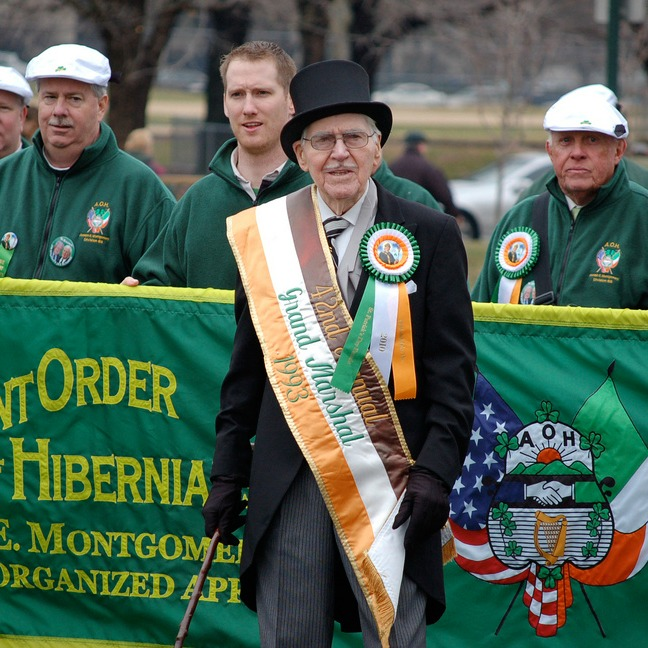
Joseph E. Montgomery
When Steve Burns first met Joseph Montgomery, he remembers, “I thought he was a retired lawyer or executive. He was a very polished gentleman, in his demeanor and his dress, he always wore a suit and a tie. He was very articulate.”
It wasn’t until a couple of years later that Burns, then a relatively new member of Ancient Order of Hibernians Division 65, found out the truth about the division’s nattily dressed president.
“It was in a conversation with another member,” Burns recalled. “I learned he was a truck driver for 20 years, a proud Teamster.”
Like so many, Burns, now vice president of what came to be known as the Joseph E. Montgomery Division, is grieving the loss of his old friend. Joe Montgomery died this week at age 95.
There was a lot to know about Joe Montgomery:
- A graduate of Roman Catholic High School, Montgomery served in the Army Air Corps during World War II.
- He was a member of Philadelphia St. Patrick’s Day Observance Association for six decades, and was a past president. In 1993, he was the parade’s grand marshal. With his neatly combed-back white hair and perfectly trimmed mustache, it’s hard to think of anyone who ever looked more dapper in a top hat and morning coat.
- He served on the advisory committee of the Treasures of Irish Art.
- He was secretary of the Irish Participation Committee of the 41st International Eucharistic Congress.
Most people would say, though, that Joe Montgomery’s first love—after his late wife Mary—was the Ancient Order of Hibernians. Montgomery was one of a handful of guys who kept Division 65 going through lean times, Burns said, when meetings would typically draw only six to eight members. He served four terms as president of the Philadelphia County Board, as well as Pennsylvania State Board president. He was accorded the honor of Gold Card Life Member, the AOH’s highest honor.
It’s safe to say Montgomery was a fixture within the AOH, incredibly well known and loved. Burns was one of several younger members of Division 65 who would accompany Montgomery to conventions. Former national AOH President Seamus Boyle christened Montgomery’s entourage “Joe’s altar boys.”
Everybody in those gatherings knew Joe Montgomery, Burns said. When Montgomery would enter a hospitality room, everyone greeted him warmly. “They just had sincere respect for what he’d done.” In recent years, Montgomery wasn’t well enough to attend conventions, but, still, “all the national people would ask, ‘How’s my buddy Joe?’”
All of those years of dedication to the AOH were recognized in what, for the AOH, was a unique way.
“I got this idea in the late ‘90s, around our 100th anniversary,” Burns said. “I saw that all the other divisions had names. I said, “How come we don’t have a name? Why don’t we name the division for Joe?”
Typically, AOH divisions are named after deceased persons and religious figures. “They said, ‘Oh, God, we can’t do that, he’s still alive.’ And I said, ‘That’s my point. Let’s honor Joe while he’s still with us.’”
Thus, the division became the only one named after a living person.
News of Montgomery’s passing hit Burns hard, as it did so many of his friends and acquaintances.
Still, he’s grateful for his memories—one in particular.
Burns has a house at the shore, and last August there was a fund-raiser for the Hibernian Hunger Project down near his home. Travel was hard for Montgomery, but Burns arranged to pick him up at his home, and take him down to South Jersey for a weekend.
“All the Philadelphia guys were down there, all the guys he’s known for years. He really enjoyed it. That was my last trip with Joe. I’m so glad to have had that weekend with him.”
Many more of Joe Montgomery’s friends have agreed to share their thoughts and remembrances. Here they are:
Patrick Mulhern, president, AOH 65, Joseph Montgomery Division
I can’t express in words the admiration I had for Joe. He taught me so much about the AOH, and he was the impetus behind me running for a division office and ultimately division president.
I was constantly amazed to see the respect he garnered at not only State but also National Conventions over the years. I always said the only thing missing was a ring to be kissed.
He had more sayings, and one-liners that permeated his great sense of humor.
Joe’s mind was so sharp, and I couldn’t believe how he remembered everyone’s name, even those whom he met very infrequently. He always had a smile and treated all with respect.
I will remember Joe as the epitome of an Irish Gentleman, consider myself better for having known him, and will sadly miss his friendship and countenance.
Chris Phillips, president, St. Patrick’s Day Observance Association (SPDOA)
Over the last few years Joe has reached out to me about Malvern Retreat House, and making a retreat over the last few years.
The group I had gone with my DAD over the last 35 years had an AOH group. So, long story short, Joe would call me personally and ask me for MY help to get my dad to the retreat. I found great pride that he would reach out to me, and it did my heart good when he was there to make his last retreat last February. And why? Because he thanked me personally, and told me how much he appreciated my help.
Again, he was a pure gentleman, a real man who did more for others than he ever did for himself.
Joe Montgomery’s influence on the Delaware Valley American Irish community is timeless, and a true example for all of us on how to be a TRUE American Irish Gentleman.
May the road rise up to meet you.
May the wind be always at your back.
May the sun shine warm upon your face;
The rains fall soft upon your fields
And until we meet again,
May God hold you in the palm of His hand
May God bless his family, and may all of us keep them in our thoughts and prayers in the days to come.
Judge Jimmy Lynn
I am deeply saddened to hear of the death of the great Irish Patriot, Joseph Montgomery. It’s difficult to conjure that I will not see my friend, Joe, at a SPDOA meeting or at the parade, or anywhere else our clan comes together. I have known Joe since I was a little boy of 5 or 6, or maybe even earlier—my whole life. He is directly connected with, and is a part of the very core of my love of the celebration of being Irish. He is the parade to me.
I am even sadder for Joe’s wonderful family for they know him better than anyone, and their hearts are seared by his departing beyond what any of us can know.
I will miss hearing his wise counsel; his wonderful and powerful singing voice (although he has been unable to sing for a good while); his humor; talking about staying in shape—doing 100 push-ups every day and lifting weights. Me: “Joe, you still lifting weights?” Joe: “No, Jim. The doctor told me that at 92, I better put the weights down. But I’m still doing the push-ups!”—and his way of sizing up a man that may have gotten on his nerves. (“That guy could give an aspirin a headache!).
This loss is a big loss for us. He may be 95, but it is still a big punch in the gut. As Chris Phillips said, his influence on the Delaware Valley Irish community is “timeless.” I would only add to that the entire Irish community in the United States, because if you ever had the opportunity to attend a National AOH convention you would have seen people from everywhere in the country hanging around Joe like bees to honey.
Joe, I miss you already. Now, you are with your sweet and kind and lovely Mary. Say hello to Uncle Bud for me.
God bless you and keep you, Joe.
I’ll see you when I see you.
Sister James Anne Feerick
Joe was a great friend for many years. We met at Transfiguration Parish in the choir ( 1957). He was always a great gentleman. I will miss him. Rest with Mary, Joe.
Austin McGreal, SPDOA Executive Committee
I had the privilege of serving on SPDOA with Joe since he joined our organization many years ago.
He always adhered to and promoted the dignity of the parade, and contributed significantly to keeping it close to its original purpose. This attitude was merely a reflection of the dignity Joe personified—a truly wonderful human being.
‘Til we meet again, Joe.
Kathy McGee Burns, SPDOA Executive Committee
Joe Montgomery was a gentleman. He was a lovely, thoughtful, dignified man who respected everybody. He thought of women as equals. In an article I wrote about him, I said he was a man’s man, but he was also a ladies’ man. He was debonair, charming and handsome, and he treated women as his equal.
I am thrilled to say that I was given the Joseph Montgomery AOH Division 65th 3rd annual award, and the first woman to receive this great award.
I loved Joe Montgomery, and the day I was named grand marshal, he was the first person I called…and he was thrilled for me.
What a loss!
Michael Bradley, Philadelphia St. Patrick’s Day Parade Director and Division 65 Board Member
I was asked to give my personal thoughts on Joe Montgomery, he has been around my life for so long, it will be hard not to see him again.
Joseph E. Montgomery, 95 years young, ( Joe was never an old man) was an absolute gentleman in every sense of the word. He was passionate about Irish issues and as well known a figure at the National AOH Level as anyone in the United States of America.
I had the proud pleasure of being the co-chairperson and MC the night of our 100th Anniversary of AOH Division 65 in 1998 when we unveiled the banner proclaiming the division to be forever known as the AOH Joseph E. Montgomery Division 65. It was the only division in the world ever named after a living person. When I looked over, I saw the banner had incorrectly placed a “J.” for his middle initial instead of an “E.” I waved my hand in front of the banner like Vanna White waving at the letters on TV, and kept it there so the photographs could not show the mistake. Hardly anyone noticed and when the photos stopped, Joe leaned over to me and said, “I don’t know what you are doing, but I know you are up to something or you would have moved out of the way.” He was 80 years young at that time, and no Philly detective had anything on Joe Montgomery.
After the ceremony, in true Joe fashion, he came up to me at the microphone and said that, while he was thrilled beyond belief at the honor, he was heartbroken his beloved Mary was not with him there to share the moment. She had recently passed away, and he often said about her that she was in the AOH, not the LAOH, because she was so involved with him in his AOH and parade activities.
Joe never cared for anyone who promoted themselves, he kept to himself and never bragged, and the honors came to him rightfully so, non-stop every year. You could fill the Irish Center with the awards that Joe has received, but none greater than naming our AOH Division 65 after him.
Joe was president for 40 years and a member for over 70 years! Joe was very proud of our division, and I was just as proud not only to be in his division, but to consider him a friend and mentor.
I was fortunate enough that, when he was elected into the Delaware Valley Irish Hall of Fame in 2009, he asked me to give his presenting speech. I started it off with “ Joe’s first job was as a waiter at the Last Supper!” He leaned over, and I expected him to clobber me and but said “That was a good one,” and leaned back in his chair and laughed!
He was our Philadelphia St. Patrick’s Day Parade Secretary for over 40 years, and the last five had me take work with him doing our minutes as his hearing was starting to slip. I was secretary for our AOH for a number of years and knew how particular he was for details. He would be furious when someone would send minutes out that were not done professionally. So he asked me to help him with parade minutes. I would type them in great detail as he always requested, and send them to him for him to add or correct. There were always adds or corrections!!! He showed me his notes from meetings 30 years ago, and they were in longhand and in perfect Palmer method penmanship. Not a detail missed. I can honestly say that I learned to be detail-oriented by my parents, and then taken to a higher level of detail by Joe Montgomery.
Joe absolutely beamed when he brought up his children, grandchildren and great-grandchildren and telling us stories. Joe was very proud of his Roman Catholic High School graduation and representing our country in the Army Air Corps in WWII.
Joe was also a proud member of the Teamsters Local 500. He was married to Mary for over 50 years, on our parade board for 60 years, and if you see a recurring theme here, stability was his mantra. Everything he did was to the very best of his ability. He was a proud Catholic and honestly, I never heard anyone say a bad word about the man.
When he knelt at church at our parade Mass in March, I noted to myself that he was kneeling straight as anyone in St. Patrick’s Church, and people one-third his age were leaning back on the pew. He was giving honor to Jesus, who was tortured and died on the cross for us, and kneeling for a few minutes out of respect to our Lord. I thought if Joe Montgomery at 95 can kneel straight up in Mass, then so can I. Minor detail, I think not, but another important lesson learned just from watching him.
Joe had many, many funny sayings. Among them:
“ He or she could give an aspirin a headache”.
“ You can’t shove a crooked stick up a straight man’s arse (I never heard him curse, that was the closest!) meaning someone was lying to him or full of it.
“You’ve got to do your own growing, no matter how tall your grandfather was.”
Memories:
- He was at home with the ambassador to Ireland or common everyday workers.
- He was equally adept at drinking DRY gin martinis and or Budweiser.
- He was still driving at 93 but complained he couldn’t see so well at night!
- At 86, he told me that he had to cut down on playing basketball because his legs were slowing down.
- I told him he never passed the ball anyway, and I’m sure the guys wouldn’t mind. He just laughed that legendary laugh of his.
- He used to sing Irish songs at the end of the night, and you could hear a pin drop as the respect this man had was unbelievable.
- He was in a tux at the parade and I told him he looked like the guy on the Monopoly game board, and he said he wished he had the money from the game.
- He was always dressed to the nines with his color coordinated handkerchief in his suit coat pocket.
In closing I have two goodbyes to Joseph E Montgomery, who made me a better son, brother, father & husband by his wisdom, compassion, street smarts and professionalism:
1.)
Death leaves a heartache no one can heal, love leaves a memory no one can steal.
2.)
A death as occurred and everything is changed.
We are painfully aware that life can never be the same again,
That yesterday is over,
That relationships once rich have ended.
But there is another way to look upon this truth.
If life now went on the same,
Without the presence of Joe Montgomery,
we could only conclude that the life we remember
made no contribution,
filled no space,
meant nothing.
The fact that Joe left behind a place
that cannot be filled is a high tribute to this individual.
Life can be the same after a trinket has been lost,
but never after the loss of a treasure.
Rest in peace, Brother!
Funeral details are here.
If you’d like to share your remembrances, feel free to add them in the comments section, below.

